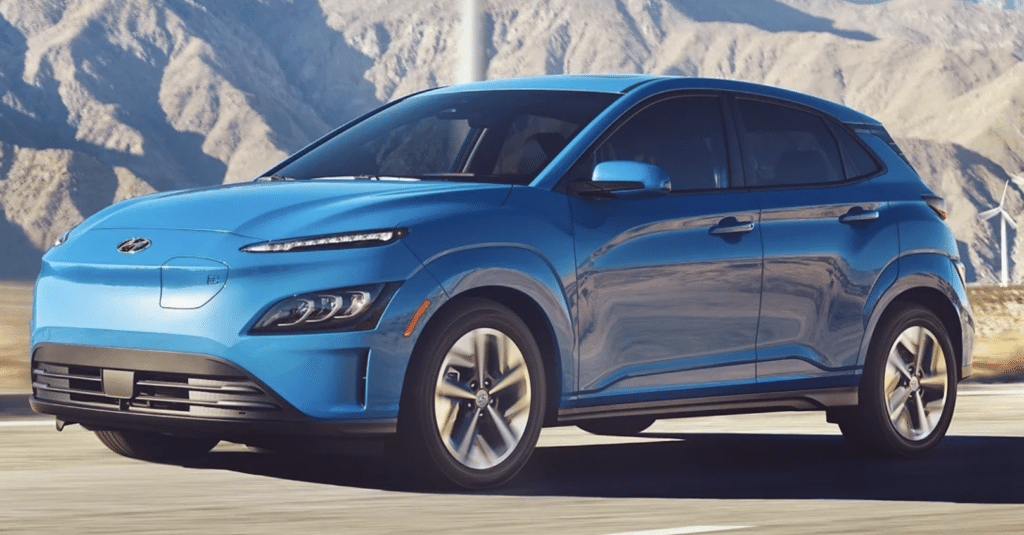Overview – Hyundai Kona Electric
The 2022 and 2023 Hyundai Kona Electric are subcompact SUV models that offer a fun driving experience. While the 2023 model shares many of its features with the gas-powered Kona, the 2022 model is a fully electric SUV with a restyled exterior and added tech, convenience, and safety features.

Both models offer excellent value and a great range, but the 2022 model is more budget-friendly than other EVs on the market. The Kona Electric is a competitive option in the small-EV market.
Hyundai Kona Electric – Energy And Carbon Efficiency
The Hyundai Kona Electric has a carbon efficiency of 83 gCO2/mi, which places it at about the midpoint when compared to the other electric vehicles in your list.
Looking at other electric cars, the Dacia Spring Electric, Opel Astra Electric, Renault Megane E-Tech EV60 130hp, and Jeep Avenger Electric 1st Edition all outperform the Hyundai Kona Electric in terms of carbon efficiency, with gCO2/mi values of 67, 75, 79, and 80 respectively.
The Hyundai Kona Electric is exactly on par with the Hyundai IONIQ 6 Standard Range 2WD and DS 3 E-Tense, all of which have a carbon efficiency of 83 gCO2/mi.
Others from the Lucid Air Grand Touring to the Audi SQ8 e-tron, have higher gCO2/mi values ranging from 88 to 142, indicating that they are less carbon efficient than the Hyundai Kona Electric.
EV Engine, Power and Performance
Both models feature a 201-hp electric motor powered by a 64.0-kWh battery pack and offer a claimed driving range of 258 miles per EPA estimates. The 2022 model managed to achieve a range of 315 miles during range testing.
It provides sprightly driving dynamics, engaging even on twisty two-lanes. Aggressive regenerative braking allows for one-pedal driving, and it can come to a complete stop. Both models cruise comfortably at highway speeds, thanks to the low center of gravity from the heavy battery mounted in the floor.
Interior Comfort and Cargo Dimensions
Both models offer a comfortable interior made from quality materials and rich in features. The cabins feel airy, and there is plenty of head and legroom up front. The 2022 model has a wide rear seat area, but it lacks rear legroom.
The Kona Electric’s rear seat and cargo area are tight, but there’s no less room inside the Electric than the standard model. Both models have suitable storage space for small items, but the cargo area behind the rear seats is not the biggest in its class.
Infotainment, Tech and Connectivity
Both models come with a touchscreen infotainment system featuring Apple CarPlay and Android Auto capability. The 2022 base SE model comes with an 8.0-inch touchscreen, while upgrading to the SEL or Limited adds a 10.25-inch display with navigation. The 2023 model offers a 10.3-inch display as an option.

Both models have wireless Android Auto/Apple CarPlay smartphone connectivity, a wireless charging pad, and several other tech and convenience features, including adaptive cruise control. The 2023 model comes with a 10.3-inch reconfigurable digital gauge display, while the 2022 Limited add-on includes a head-up display and rear parking sensors.
Safety Features
Both models are outfitted with several driver-assistance features, including blind-spot monitoring and automated emergency braking as standard. The 2022 model has forward collision mitigation, while the 2023 model also has lane keeping assist. The top-spec 2022 Limited trim adds rain-sensing windshield wipers and adaptive cruise control.
Warranty Information
Hyundai’s legendary warranty program backs both models for five years or 60,000 miles for the limited warranty, ten years or 100,000 miles for the powertrain warranty and battery warranty, and includes complimentary scheduled maintenance for three years or 36,000 miles. No oil, oil filter, or spark plugs need to be changed due to the Kona’s electric powertrain.
Final Thoughts – Hyundai Kona Electric
The Kona Electric provides a pleasant and efficient ride with a great range, making it a competitive option in the small-EV market. Both models offer excellent value, a feature-rich interior, and an excellent warranty program. However, limited geographical availability and tight rear legroom in the 2022 model are drawbacks to consider. Other EVs worth checking out include the Chevrolet Bolt EUV, Kia Niro EV, Nissan Leaf, and Volkswagen ID.4.
Technical Specifications – Hyundai Kona Electric
| Basic Information | |
| Make | Hyundai |
| Model | Kona Electric 65 kWh |
| Car Body | SUV |
| Number Of Seats | 5 |
| Estimated Energy Efficiency | |
| Efficiency (mi/kWh) | 4.7 mi/kWh |
| Efficiency (km/kWh) | 7.5 km/kWh |
| Engine | |
| Horsepower | 215 HP (218 PS) |
| Acceleration 0-100 km/h | 8 seconds |
| Towing Weight | No data |
| Charging | |
| Charge Port | Type 2 |
| Charge Time | 7 hours |
| Fast Charge Power Max | 100 kW DC |
| Fast Charge Time | 41 min |
| Safety | |
| Adult Safety Rating | none |
| Child Safety Rating | none |
| Purchasing | |
| Available Countries | United Kingdom,The Netherlands,Germany |
| Date Of Availability | September 2023 |
| Estimated Price | £40,000 |
| Estimated Carbon Efficiency (Grid/Country Dependent) | |
| USA | 83 gCO2/mi (52 gCO2/km) |
| Iceland | 7 gCO2/mi (4 gCO2/km) |
| Canada | 18 gCO2/mi (18 gCO2/km) |
| France | 22 gCO2/mi (14 gCO2/km) |
| Efficient Gas Car | 272 g CO2/mi (170 g CO2/km) |
| Battery | |
| Size (kWh) | 65.4 kWh |
| Voltage (V) | 400 V |
| Range | |
| WLTP Range (km) | 490 |
| Dimensions | |
| Car Length | 171 inches (4355 mm) |
| Car Width | 72 inches (1825 mm) |
| Car Height | 62 inches (1575 mm) |
| Cargo (Trunk or Boot) Volume | 16 cu ft (466 L) |
| Frunk Volume | 1 cu ft (27 L) |
